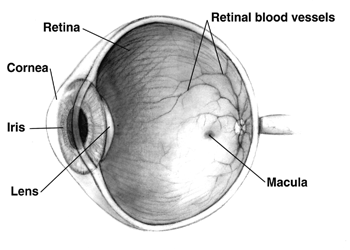Glaucoma
Glaucoma is a group of eye diseases causing optic nerve damage, potentially leading to vision loss. It is primarily associated with increased intraocular pressure (IOP) but can also occur with normal IOP. The condition progresses silently, often leading to irreversible vision loss if untreated.
Signs and Symptoms
Open-angle glaucoma typically presents without early symptoms, gradually causing peripheral vision loss, which can eventually affect central vision. Acute angle-closure glaucoma, a medical emergency, is characterised by sudden ocular pain, seeing halos around lights, red eye, very high IOP, nausea, and vomiting. Opaque specks in the lens, known as glaukomflecken, may also occur.


Risk Factors
Increased IOP is a significant risk factor, but other factors include age, family history, high blood pressure, and use of steroids. Genetic predispositions, ethnicity, particularly among African Americans, Latinos, and Asian-Americans, and specific medical conditions like diabetes and severe retinal vein occlusion can also increase risk.

Pathophysiology
Glaucoma primarily damages the optic nerve due to elevated IOP. In open-angle glaucoma, obstructed aqueous humour flow through the trabecular meshwork causes pressure build-up. In angle-closure glaucoma, the iris obstructs the drainage angle, leading to a rapid pressure increase. The exact mechanisms are not fully understood, but theories include mechanical damage from increased IOP and vascular issues reducing blood supply to the optic nerve.

Diagnosis
Glaucoma diagnosis involves comprehensive eye examinations, including IOP measurement, anterior chamber angle assessment, gonioscopy, retinal nerve fibre layer assessment via dilated fundus examination, corneal thickness measurement, and visual field testing.

Types
Glaucoma is broadly categorised into primary and secondary types. Primary includes open-angle and angle-closure glaucoma. Secondary glaucoma results from conditions like uveitis, trauma, or steroid use. Developmental glaucoma affects neonates or juveniles due to congenital abnormalities.
Visual Field Defects
Visual field defects in glaucoma are due to retinal nerve fibre layer damage, often manifesting in Bjerrum's area. Early defects include generalised depression and paracentral scotomas, progressing to arcuate scotomas and tubular vision in advanced stages.

Treatment
Medication
The primary goal is to lower IOP to slow disease progression. First-line treatments include prostaglandin analogues like latanoprost, which increase aqueous fluid outflow. Other medications include beta-blockers, alpha-adrenergic agonists, miotic agents, and carbonic anhydrase inhibitors.
Laser
Laser treatments like Argon Laser Trabeculoplasty (ALT) and Nd:YAG laser peripheral iridotomy (LPI) are used to enhance aqueous humour drainage or relieve angle closure.
Surgery
Surgical options include trabeculectomy, creating new drainage openings, and glaucoma drainage implants. Canaloplasty uses microcatheters to enhance drainage channels. Nonpenetrating deep sclerectomy (NPDS) and laser-assisted NPDS offer less invasive alternatives, reducing side effects.

Epidemiology
Globally, glaucoma affects over 44.7 million people and is the second leading cause of blindness. It is more prevalent in older adults and certain ethnic groups, notably African Americans and Asians.

History
Glaucoma's association with elevated IOP was first noted in 1622. Significant advancements include the invention of the ophthalmoscope in 1851, enabling optic nerve head examination, and the development of the first tonometer in 1905.
Research
Recent studies compare the effectiveness of eye drops versus surgical treatments like trabeculectomy for glaucoma. Neuroprotective agents and anti-VEGF treatments are also being looked at to improve outcomes.
Self-assessment MCQs (single best answer)
Which of the following is a characteristic symptom of acute angle-closure glaucoma?
What is the primary goal of glaucoma treatment?
Which of the following treatments is NOT typically used for glaucoma?
What is a common visual field defect in early-stage glaucoma?
Which diagnostic tool is used to assess the optic nerve head in glaucoma patients?
Which ethnic group is at higher risk for developing glaucoma?
Which type of glaucoma is associated with a rapid increase in intraocular pressure due to iris obstruction?
What is the purpose of Argon Laser Trabeculoplasty (ALT) in glaucoma treatment?
Which medication class is considered first-line treatment for lowering IOP in glaucoma patients?
What is the term used to describe the opaque specks in the lens associated with acute angle-closure glaucoma?
Dentaljuce
Dentaljuce provides Enhanced Continuing Professional Development (CPD) with GDC-approved Certificates for dental professionals worldwide.
Founded in 2009 by the award-winning Masters team from the School of Dentistry at the University of Birmingham, Dentaljuce has established itself as the leading platform for online CPD.
With over 100 high-quality online courses available for a single annual membership fee, Dentaljuce offers comprehensive e-learning designed for busy dental professionals.
The courses cover a complete range of topics, from clinical skills to patient communication, and are suitable for dentists, nurses, hygienists, therapists, students, and practice managers.
Dentaljuce features Dr. Aiden, a dentally trained AI-powered personal tutor available 24/7 to assist with queries and provide guidance through complex topics, enhancing the learning experience.
Check out our range of courses, or sign up now!


